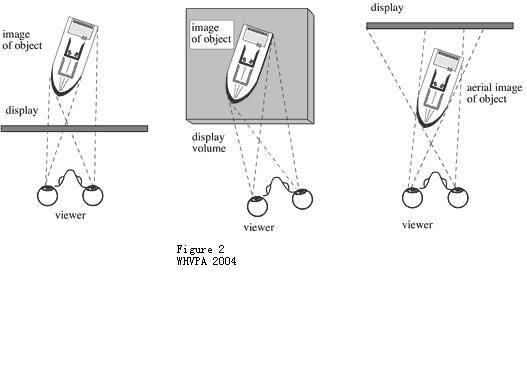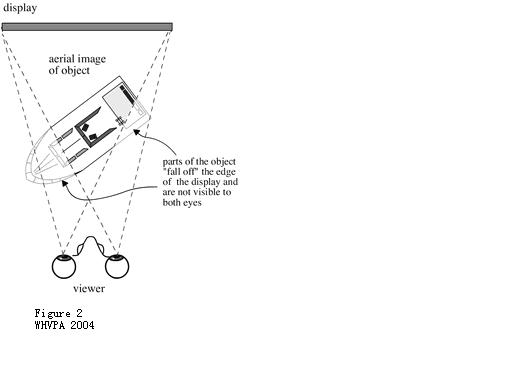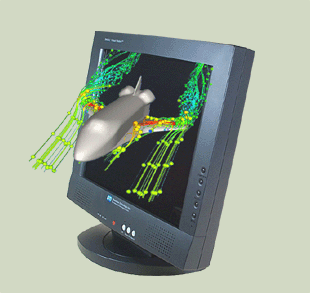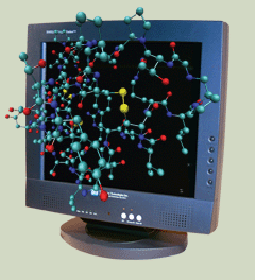| Part
Two
Project
Analysis
edra
2.2
Technical Survey
2.2.1 Autosteroscopic 3D
Abstract
Three classes of autostereoscopic displays are described: re-imaging
displays, volumetric displays, and parallax displays. Re-imaging
displays re-project an existing three-dimensional object to a
new location or depth. Volumetric displays illuminate
 points
in a spatial volume. Parallax displays emit directionally-varying
image information into the viewing zone. Parallax displays are
the most common autostereoscopic displays and are most compatible
with computer graphics. Different display technologies of the
three types are described. Computer graphics techniques useful
for three-dimensional image generation are outlined. points
in a spatial volume. Parallax displays emit directionally-varying
image information into the viewing zone. Parallax displays are
the most common autostereoscopic displays and are most compatible
with computer graphics. Different display technologies of the
three types are described. Computer graphics techniques useful
for three-dimensional image generation are outlined.
Introduction
After many years of relative obscurity, three-dimensional displays
have recently become both increasingly popular and practical in
the computer graphics community. This interest can be attributed
to many factors. In our daily lives we are surrounded by synthetic
computer graphic images in print and on television, and can now
even generate similar images on personal computers in our home.
We also have holograms on our credit cards and lenticular displays
on our cereal boxes. And has it really been so many years since
we first saw Princess Leia projected into thin air in the Star
Wars motion picture? In fact, the general public has been excited
about three-dimensional images since the days when stereoscopes
graced every mantelpiece at the turn of the century, through the
3D movie craze of the early 1950's, the wonder of holography in
the 1960's, and the new frontier of virtual reality today. With
each new technology or movie, the excitement seems to grow.

Developments in the computer graphics industry have also done
their part to make spatial images more practical and accessible.
In the business of computer graphics, the computational power
now exists for desktop workstations to generate stereoscopic image
pairs for interactive display. At the high end of the computational
power spectrum, the same advances that permit intricate object
databases to be interactively manipulated and animated also permit
large amounts of image data to be rendered for high quality three-dimensional
displays. Finally, there seems to be a general realization in
the research and scientific community that the two-dimensional
projections of three-dimensional scenes traditionally referred
to as "three-dimensional computer graphics" are insufficient
for inspection, navigation, and comprehension of some types of
multivariate data. For these databases, the oft-neglected human
depth cues of stereos, motion parallax, and to a lesser extent
ocular accommodation are essential for image understanding.

The broad field of virtual reality has driven the computer and
optics industries to produce better stereoscopic helmet- or boom-mounted
displays, as well as the associated software and hardware to render
scenes at rates and qualities needed to produce the illusion of
reality. However, most journeys into virtual reality are currently
solitary and encumbered ones: user often wear helmets or other
devices that present the three-dimensional world to them, and
only to them. Presenting a three-dimensional image to a casual
passerby, a group of collaborators, or an audience requires a
different technology: autostereoscopic displays.
Autosteroscopic Display
Autostereoscopic displays present a spatial image to a viewer
without the use of glasses, goggles, or other viewing aids. Autostereoscopic
displays are appealing because they offer the best approximation
to the optical characteristics of a real object. As a result,
though, there is much misunderstanding and misinformation by those
who would oversell the capabilities of a particular technology.
This paper will try to outline the strengths and practical limitations
of the different technologies by classifying them into broad categories.
Our current understanding of physics does not include a practical
way of forcing photons to change direction in the absence of an
optical medium. Thus, a fundamental and general statement can
be made about all spatial displays, whatever its particular technology.
This paper will refer to this requirement as the projection constraint:
A display medium or element must always lie along a line of sight
between the viewer and all parts of a spatial image.
Photons must originate in, or be redirected by, some material.
The material can be behind, in front of, or within the space of
the image, but it must be present. All claims to the contrary
violate what we understand about the world. Figure 1 shows the
possible relationships between the image and the display. A corollary
to this constraint is the observation that air, water, or smoke
are, in general, very poor display media. Images appearing "in
mid-air", called aerial images, will invariably have originated
not in the air from some other medium. Technologies lavished with
claims of mid-air projection should always be scrutinized with
regard to the fundamental laws of physics .

A specific and practical result of the projection constraint is
that no matter where a spatial image appears with respect to its
display, the image will be clipped by the display's physical boundaries.
If for instance, an image appears in front of its display, a sufficient
translation of the viewer will cause part or all of the object
to intersect and "fall off" the edge of the display.
This condition, known as a window violation, is particularly disturbing
for aerial images .Figure 2 illustrates a window violation.

Figure 2. A window violation.
Physically realizable autostereoscopic displays can be classified
into three broad categories: re-imaging displays, volumetric displays,
and parallax displays. Re-imaging displays capture and re-radiate
the light from a three-dimensional object, perhaps to a new location
in space. Volumetric displays span a volume of space, allowing
individual parts of the space to be illuminated. Finally, parallax
displays are surfaces that radiate light of directionally-varying
intensity. Displays of each type have been used in commercial
display systems, and each has inherent strengths and weaknesses.
2.2.2
Existing Tool for Autosterescopic--DTI
We cannot talk about autosteroscopic without referring to DTI.
Dimension Technologies Inc. (DTI) has developed and patented a
unique method for generating three-dimensional images by use of
stereo pairs. The results of its work have been commercialized,
and an innovative autosteroscopic display, the Virtual Window™,
was introduced.

Unlike other stereoscopic displays, DTI unit generates vivid,
full-color three-dimensional images that can be viewed without
the need to wear special eyeglasses. This feature makes the use
of the autosteroscopic displays very convenient and is particularly
important in commercial applications.
The principle of autostereoscopic image presentation is frequently
used in three-dimensional postcards and large advertising displays
that are intended to enable the observer to perceive depth by
looking at a two-dimensional picture. A stereo pair (i.e., a pair
of images corresponding, respectively, to the views through the
left and right eyes) are interlaced in alternate columns in a
two-dimensional image. A special optical device, called the "lenticular
lens," is placed in front of the interlaced image or, in
the case of a postcard, bonded directly to the front surface.
The lenticular lens is an array of very narrow vertical cylindrical
lenslets spaced to correspond to the columns of the interlaced
stereo pair. In this manner, the appropriate images of the stereo
pair are directed to the proper eyes thus generating a three-dimensional
image.
DTI has applied the same principle to its autostereoscopic displays,
which contain liquid-crystal displays (LCDs) that are viewed by
observers. To generate three-dimensional images, the LCD presents
left and right halves of a stereo pair on alternate columns of
pixels at a rate of 60 frames per second. The left image appears
on the odd columns and the right image appears on the even columns.
If the LCD in use has 1,024 columns and 768 rows of pixels, each
complete stereoscopic image consists of 512 columns and 768 rows.
Both halves of a stereo pair are displayed simultaneously and
directed to the corresponding eyes. This is accomplished with
a special illumination plate located behind the LCD and employing
a lenticular lens of the type mentioned above. Using light from
compact, intense light sources, the illumination plate optically
generates a lattice of very thin, very bright, uniformly spaced
vertical light lines. The lines are precisely spaced with respect
to pixel columns of the LCD, and, because of the parallax inherent
in binocular vision, the left eye sees all of these lines through
the odd columns of the LCD, while the right eye sees them through
the even columns, thus enabling the observer to perceive the image
in three dimensions. This arrangement, exclusive to DTI, is called
"parallax illumination."
When the halves of the stereo pair are made to correspond to the
scene perspective that would naturally be seen by the respective
eyes, a vivid illusion of three-dimensionality is created. The
objects seem to come out of the screen, giving the impression
of an open window through which objects can protrude or retreat
to the background, hence, the name Virtual Window™. In addition,
the parallax illumination system is designed such that it can
generate in the same display, at a flick of a switch, both the
stereoscopic and non stereoscopic images ?the latter at double
the resolution.

The displays are compatible with computer workstations, including
PC and Power Mac platforms, and accept real-time inputs through
multiplexers in National Television Systems Committee (NTSC) and
PAL formats from pairs of video cameras.
It is possible to produce displays that enable several people
to view in stereo at the same time. The displays are light in
weight and are available at moderate cost.
Efforts continue to further enhance the Virtual Window™
displays to obtain greater resolution, and to provide for generation
of hologram like imagery, in which objects can be observed from
different perspectives, and, most importantly, in developing applications.
For scientific applications, some areas of interest include the
display of multidimensional graphs and tables, molecular structures,
turbulent flows, biological and artificial structures, and images
obtained by use of stereo microscopes. Other applications include
remote control of vehicles and robots, inspection of luggage and
parcels, quality assurance in the production of semiconductor
devices and other miniature structures, aircraft and spacecraft
cockpit displays, interpretation of aerial photography, medical
imaging including endoscopy, and, last but not least, such consumer
products as video games and three-dimensional television.
more information about
DTI, please visit http://www.dti3d.com/
2.2.3 Other Possible Applications and Problems
need to be solved
Applications of the autostereoscopic display include:
- Scientific Visualization;
- Medical Imaging;
- Tele-presence ;
- Gaming;
- CRT Based systems;
These are possible
applications of autostereoscopic 3D in commercial use in the near
future. But, since autostereoscopic 3D is a new technology, many
bottlenecks restrict its development and currently, the most urgent
problems of autostereoscopic 3D should be solved are:
- Need For Flexible
Viewing Technology. Now, when a user sit in front of a DTI monitor,
he needs to adjust his eyes position to get an ideal visual
effect. That means the monitor does not have any auto eye tracking
technology. It is impossible for a viewer to keep the same position
for long time without any motion, so auto-adjusting technology
is much urgent for auto stereoscopic 3D researchers and commercial
developers;
- Low Resolution.
Compared with normal CRT or LCD, when viewing autostereoscopic
3D images, DTI monitor seems to sacrifice the image's resolution
for autostereoscopic visual effect. But what end-users and customers
need is autostereoscopic 3D effect plus high clarity. The technical
dilemma of 3D effect and high resolution should be given a perfect
compromise by researchers;
- Pricing Problem.
This is a more commercial than technical problem but personally
I do not think this is a serious problem that tackle autostereoscopic
3D development because the prices of autostereoscopic 3D terminals,
such as DTI monitor, PDA or mobile phones are going down steadily
and more and more people are capable of affording such a device.
>>Next
Page>>
|


 points
in a spatial volume. Parallax displays emit directionally-varying
image information into the viewing zone. Parallax displays are
the most common autostereoscopic displays and are most compatible
with computer graphics. Different display technologies of the
three types are described. Computer graphics techniques useful
for three-dimensional image generation are outlined.
points
in a spatial volume. Parallax displays emit directionally-varying
image information into the viewing zone. Parallax displays are
the most common autostereoscopic displays and are most compatible
with computer graphics. Different display technologies of the
three types are described. Computer graphics techniques useful
for three-dimensional image generation are outlined.




